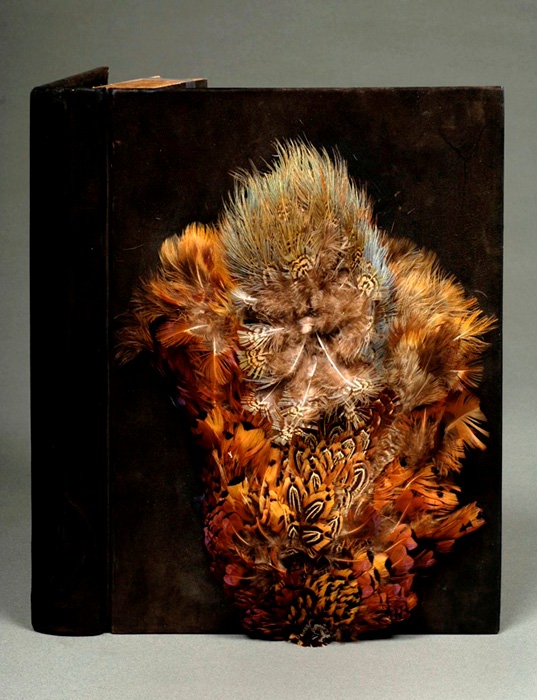Richard Minsky
Hudson, New York
Jacob H. Studer, The Birds of North America, 1888

Bound in full reverse calf with salted pheasant skin sewn onto front cover with linen thread; doublures of reverse Nigerian goat skin, hand painted flyleaves; cord image under spine leather. In 1975 this book was the center of a controversy at a Guild of Book Workers exhibit at Yale, crystallizing a central idea behind Minsky’s subsequent work—using materials as a metaphor for the content of the book. The dead bird recalls the techniques of nineteenth-century naturalists who routinely shot animals so they could draw them more accurately. Asked how this kind of book should be shelved, Minsky replied, “You don’t stick it on a shelf next to other books. It’s a work of art, like a sculpture, and you exhibit it like that.” 38 x 31 x 5 centimeters. Created 1975. Lent by William and Mary Shea Herzog.
Richard Minsky, born in 1947, is one of the most influential book artists, first being introduced to the book arts in 1960 when at the age of thirteen he purchased his printing press. He studied bookbinding with Daniel Gibson Knowlton in Providence, Rhode Island, and in 1974 founded the Center for Book Arts in New York (CBA) making it the model for subsequent centers to follow. While a traditionally trained bookbinder, his work has long challenged traditional bookbinding aesthetics, moving the book from an expression of craft to art, and influencing generations of book artists to use the materials and structure as metaphors for the work. The Birds of North America featured a salted pheasant skin recalling the techniques of nineteenth-century naturalists who shot the animals they depicted. Other works by Minsky have featured barbed wire, rat skin and a gas mask. An innovator in many areas, Minsky was one of the first book artists to make use actively of the Web as a means for showcasing his own work and as an outreach tool. He is highly sought after as a speaker and workshop presenter. His work is held in collections worldwide, including Yale University Library, the Getty Research Library, The Metropolitan Museum of Art, and the Victoria and Albert Museum. Website at www.minsky.com.